
An impact crater is an approximately circular depression in the surface of a planet, moon, or other solid body in the Solar System or elsewhere, formed by the hypervelocity impact of a smaller body. In contrast to volcanic craters, which result from explosion or internal collapse, impact craters typically have raised rims and floors that are lower in elevation than the surrounding terrain. Impact craters range from small, simple, bowl-shaped depressions to large, complex, multi-ringed impact basins. Meteor Crater is a well-known example of a small impact crater on Earth.
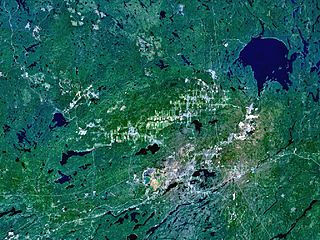
The Sudbury Basin, also known as Sudbury Structure or the Sudbury Nickel Irruptive, is a major geological structure in Ontario, Canada. It is the third-largest known impact crater or astrobleme on Earth, as well as one of the oldest. The crater formed 1.849 billion years ago in the Paleoproterozoic era.
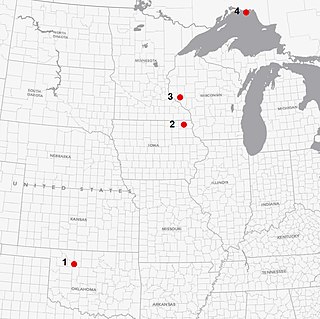
Ames crater is a meteorite crater (astrobleme) in Major County, Oklahoma, United States. Ames, Oklahoma is near the center of the structure. and 30 miles (48 km) southwest of Enid, Oklahoma. Buried under a thick layer of sediment, it was not discovered until 1991. Subsequent drilling within the crater, found a large amount of oil and gas. It is one of the largest of six meteor craters associated with oil-producing formations in the United States.

Aorounga is an eroded meteorite impact crater in Chad, Africa. The exposed remnant of the crater is 12.6 km (7.8 mi) in diameter and its age is estimated to be less than 345 million years.
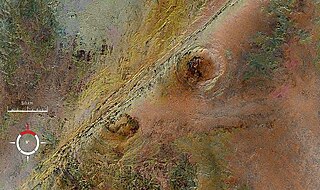
The Arkenu structures, also known as the Arkenu craters, are a pair of prominent circular geological structures in eastern Libya. The structures are approximately 10 kilometres (6.2 mi) and 6.8 kilometres (4.2 mi) in diameter, and lie about 70 kilometres (43 mi) west of Jabal Arkanu on the eastern margin of the al-Kufrah Basin.

The Boltysh crater or Bovtyshka crater is a buried impact crater in the Kirovohrad Oblast of Ukraine, near the village of Bovtyshka. The crater is 24 kilometres (15 mi) in diameter and its age of 65.39 ± 0.14/0.16 million years, based on argon-argon dating techniques, less than 1 million years younger than Chicxulub crater in Mexico and the Cretaceous–Paleogene boundary. The Chicxulub impact is believed to have caused the mass extinction at the end of the Cretaceous period, which included the extinction of the non-avian dinosaurs. Unlike the Chicxulub impact's effects, a 2021 study suggests that the Boltysh impact "did not factor into the apocalyptic die-off of the dinosaurs."

Kgagodi is an exposed meteorite crater in Botswana, roughly 7 kilometres south of the village of Kgagodi, where it got its name.

Maple Creek is a subterranean meteorite crater in Saskatchewan, Canada. It is 6 km (3.7 mi) in diameter and the age is estimated to be less than 75 million years. The crater is buried beneath younger sediments and cannot be seen at the surface.
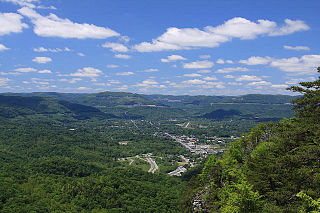
The Middlesboro crater is a meteorite crater in Kentucky, United States. It is named after the city of Middlesborough, which today occupies much of the crater.

Mistastin crater is a meteorite crater in Labrador, Canada which contains the roughly circular Mistastin Lake. The lake is approximately 16 km (9.9 mi) in diameter, while the estimated diameter of the original crater is 28 km (17 mi). The age of the crater is calculated to be 36.6 ± 2 million years (Eocene).

Rochechouart crater is an impact crater in France. The initial crater shape and structure has been lost by erosion and there is no crater visible on site; therefore it is more accurately described as Rochechouart impact structure.

Sierra Madera crater is a meteorite crater (astrobleme) in southwestern Pecos County, Texas, United States. The central peak of the rebound structure of the impact crater rises 793 ft (242 m) above the surrounding land. The peak is visible from U.S. Highway 385 between Fort Stockton, Texas and Marathon, Texas. The Sierra Madera crater is located on private property on the La Escalera Ranch.

Tookoonooka is a large meteorite impact crater (astrobleme) situated in South West Queensland, Australia. It lies deeply buried within Mesozoic sedimentary rocks of the Eromanga Basin and is not visible at the surface.

Woodleigh is a large meteorite impact crater (astrobleme) in Western Australia, centred on Woodleigh Station east of Shark Bay, Gascoyne region. A team of four scientists at the Geological Survey of Western Australia and the Australian National University, led by Arthur J. Mory, announced the discovery in the 15 April 2000 issue of Earth and Planetary Science Letters.
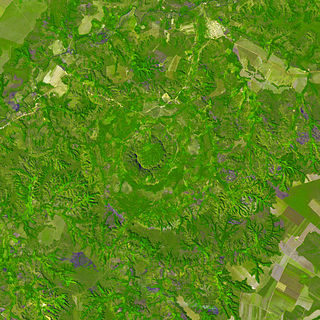
Serra da Cangalha is an impact crater in the State of Tocantins, near the border of Maranhão State, in north/northeastern Brazil. The crater is between 12 and 13 kilometres in diameter, making it the second-largest known crater in Brazil. Its age is estimated to be about 220 million years. The name means Pack-Saddle Mountains in Portuguese.

The Lac Wiyâshâkimî, also called the Clearwater Lakes in English, is a calque of Wiyâšâkamî in Northern East Cree and Allait Qasigialingat by the Inuit, are a pair of annular lakes on the Canadian Shield in Quebec, Canada, near Hudson Bay.

An impact structure is a generally circular or craterlike geologic structure of deformed bedrock or sediment produced by impact on a planetary surface, whatever the stage of erosion of the structure. In contrast, an impact crater is the surface expression of an impact structure. In many cases, on Earth, the impact crater has been destroyed by erosion, leaving only the deformed rock or sediment of the impact structure behind. This is the fate of almost all old impact craters on Earth, unlike the ancient pristine craters preserved on the Moon and other geologically inactive rocky bodies with old surfaces in the Solar System. Impact structure is synonymous with the less commonly used term astrobleme meaning "star wound".
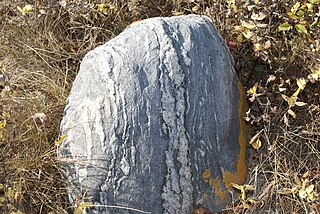
The geology of Saskatchewan can be divided into two main geological regions, the Precambrian Canadian Shield and the Phanerozoic Western Canadian Sedimentary Basin. Within the Precambrian shield exists the Athabasca sedimentary basin. Meteorite impacts have altered the natural geological formation processes. The prairies were most recently affected by glacial events in the Quaternary period.

Ramgarh crater, also known as Ramgarh structure, Ramgarh Dome and Ramgarh astrobleme, is a meteor impact crater of 3.5 kilometres (2.2 mi) diameter in Kota plateau of Vindhya range located adjacent to Ramgarh village in Mangrol tehsil of Baran district in Rajasthan state of India. When formally accepted as the third crater in India, its diameter size would be between the two already confirmed craters in India - Dhala in Madhya Pradesh with 14 km diameter and Lonar in Buldhana district of Maharashtra with 1.8 km diameter.






















